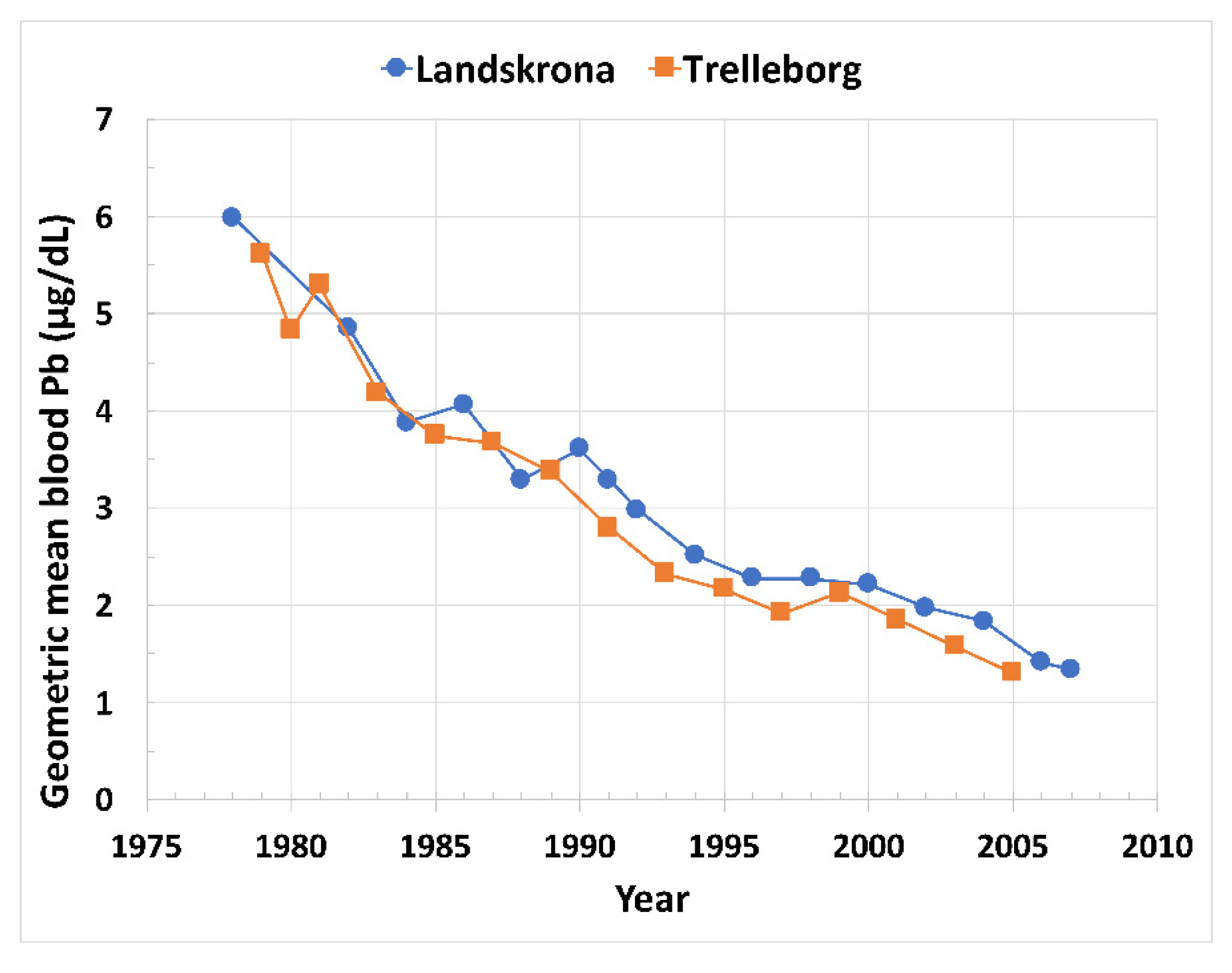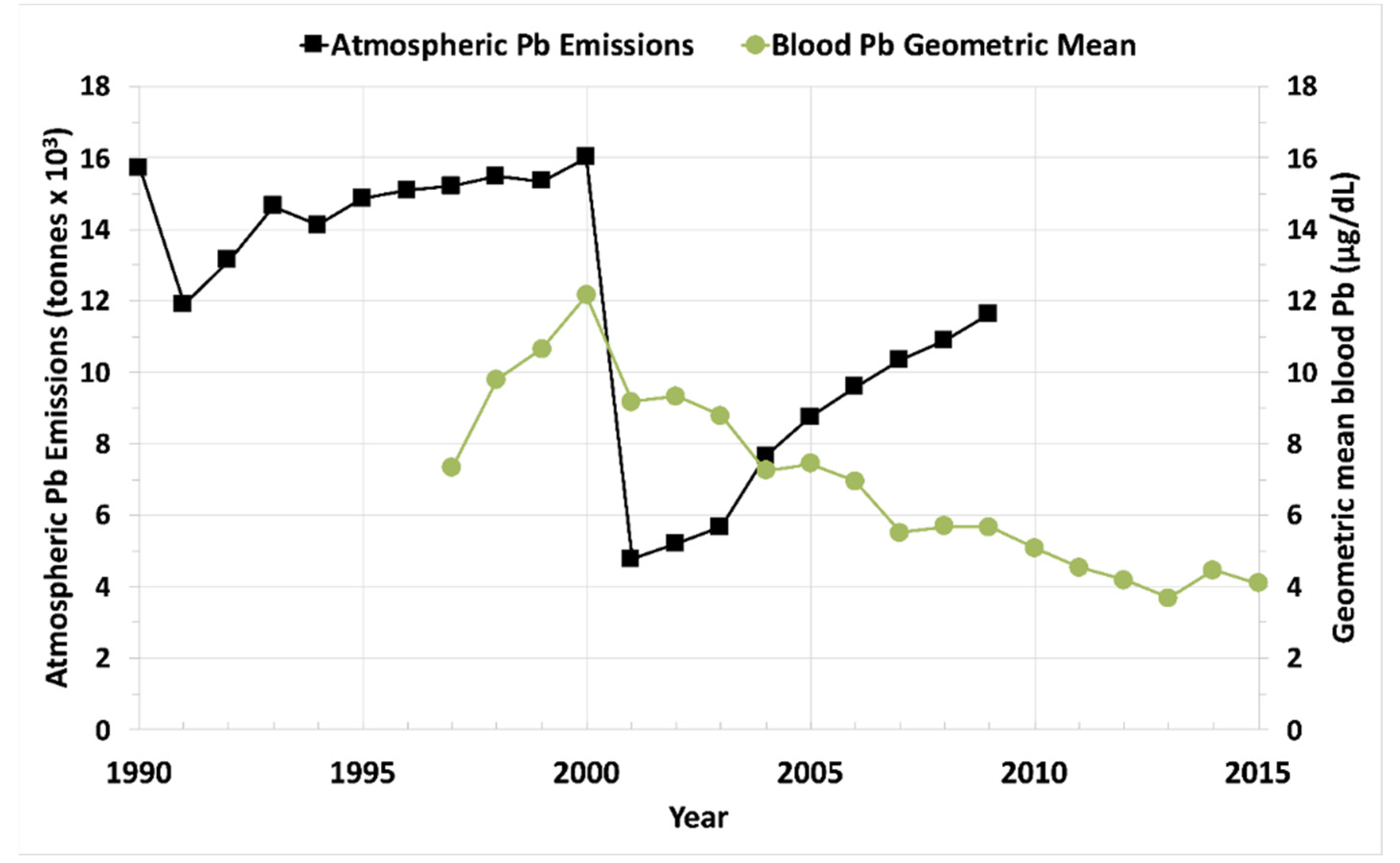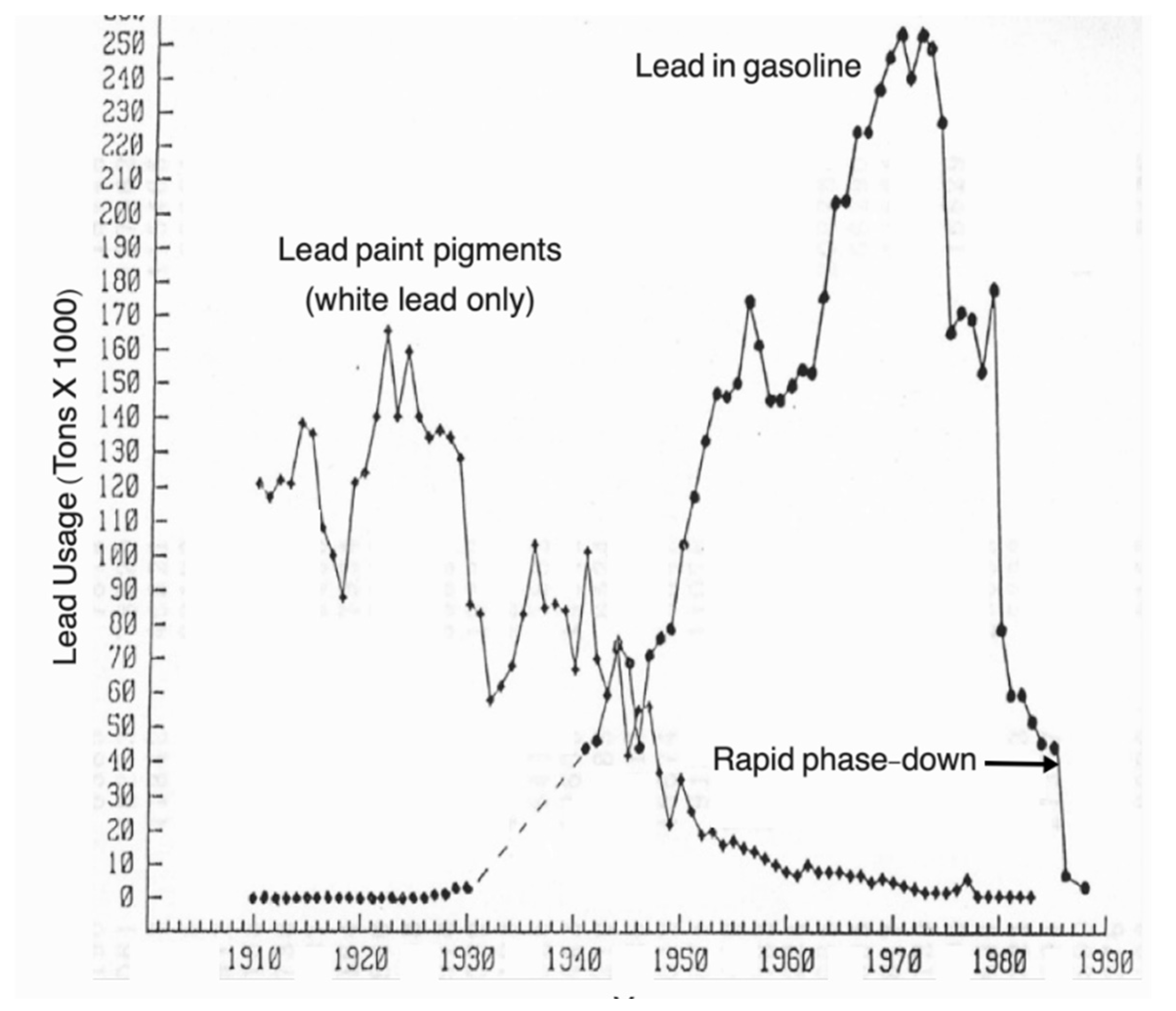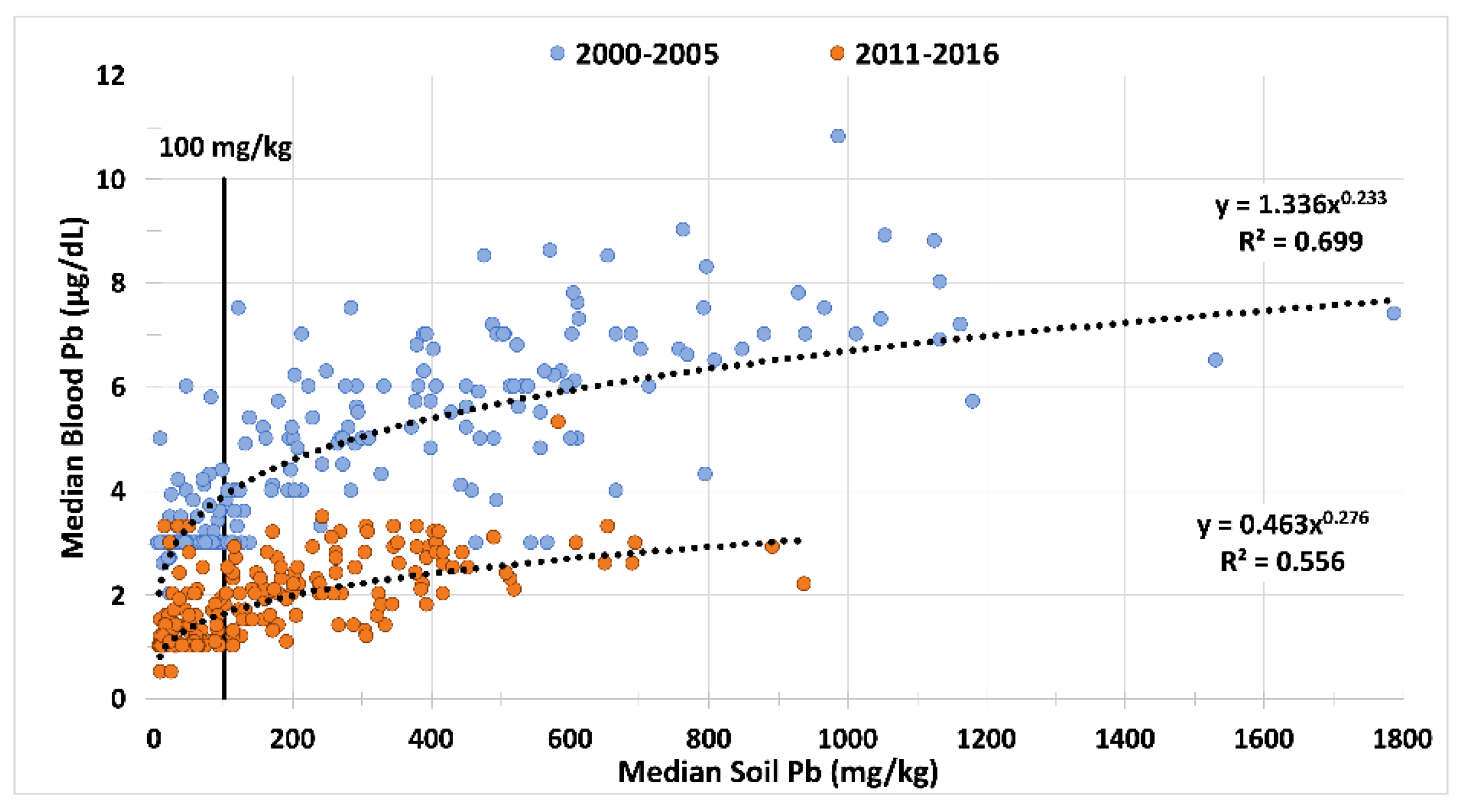Lead in Air, Soil, and Blood: Pb Poisoning in a Changing World
Abstract
1. Introduction
“Now I feel fairly sure of what I am going to say, and that is this: … If the case involved ingested lead and if [the physician] had a good medical education and if he knew the man had a stomachache and certain other symptoms of lead poisoning, he would size it up as lead poisoning. But if the material is inhaled—and its symptomology is altered when it is inhaled, because of its wider distribution in the body—it is extremely likely that nine hundred and ninety-nine ordinary physicians out of a thousand would fail to recognize the condition as lead poisoning.” Yandel Henderson, 1925 [1].
2. Materials and Methods
3. Results
3.1. Blood Pb Results from Sweden, China, Germany, and Australia
3.1.1. Sweden, Yearly Measurements of Blood Pb in Swedish Children
- From 1978 to 1994, in small Swedish cities there was a gradual reduction of blood Pb coinciding with a gradual reduction in leaded petrol [15].
- Sweden’s petrol became Pb-free in 1995.
- In 1995–2007, children’s blood Pb declined and stabilized at ~2 µg/d (Figure 2).

3.1.2. China, Asir Pb and Blood Pb of Urban and Rural Children
- This study noted three phases in blood Pb change [16].
- In 1997–2000, before the phasedown of leaded petrol, blood Pb increased rapidly.
- After the phasedown, in 2001–2013, blood Pb decreased rapidly.
- According to the raw data, in 2014–2015, blood Pb stabilized.
- The raw data blood Pb are from urban surveys, while air Pb is from multiple industrial surveys. As a result, the two surveys are not necessarily associated.

3.1.3. Germany, Pb Exposure >35 Years of 20–29-Year-Old Compared with the Same Aged US young Adults
- Data from the early 1980s to 2019 reveal a blood Pb decrease of about 87% [17].
- The US 20–29-year-old young adults represent rural, suburban, and urban areas.
- The trends in human exposure closely correlate with air Pb levels.
- Since 2010, blood Pb in German young adults have flattened to ~1 µg/dL.
3.1.4. Australia, the Rise, Fall, and Remobilization of Industrial Lead
- Australian environmental Pb emissions began in the 1880s.
- Environmental archives contain multiple natural Pb isotopic values.
- The decline in leaded petrol coincides with urban blood Pb.
- Leaded petrol continued to decline but urban blood Pb stabilized at <2 µg/dL
- Around mines and smelters, blood, air, and soil Pb remain elevated.

3.2. Air Pb, Soil Pb, and Blood Pb
3.2.1. London, UK, Evidence for 20th Century Pb Deposition being Remobilized into the Atmosphere
- Britain banned leaded petrol at the end of the 20th century [26].
- Prior to the ban, Pb from exhaust particles were deposited in soils.
- Leaded petrol was the main source of Pb during the 20th century.
- Pb isotopes of air particles collected in London (2014–2018) were measured [26].
- Pb isotopic composition of air particles matched road dust and topsoil Pb.
- Persistence of Pb indicates that London reached an air Pb baseline.
- The policy measures in London are insufficient to decrease the Pb baseline [26].
3.2.2. New Orleans, LA, USA, the Concurrent Decrease of Soil Pb and Blood Pb
- A 19-year study evaluated changes in soil Pb and blood Pb after the 1986 rapid phasedown of leaded gasoline [27].
- Reservoirs of soil Pb persist in topsoil from fuel emissions and other Pb sources, which can become Pb dust.
- Over ~15 years, the median soil Pb decreased from 99 to 54 mg/kg as mapped in Figure 6. The spatiotemporal declines in soil Pb and blood Pb are presented in Figure 7.Figure 6. Spatiotemporal declines of soil Pb in New Orleans. The maps of New Orleans were created from a citywide survey of the metropolitan communities (n~5400 soil samples systematically collected across 274 census tracts) [27].Figure 6. Spatiotemporal declines of soil Pb in New Orleans. The maps of New Orleans were created from a citywide survey of the metropolitan communities (n~5400 soil samples systematically collected across 274 census tracts) [27].Figure 7. Graph of the median blood Pb (µg/dL) on the y-axis and median soil Pb (mg/kg) on the x-axis. Two surveys of New Orleans over an interval of ~15 years illustrate the concurrent decrease in both blood Pb and soil Pb. The high blood Pb census tracts correspond with high soil Pb. The Fisher’s Exact p-values are <10−36. As illustrated in Figure 5, the most contaminated areas are clustered in the inner-city where the highest children’s blood lead values are found. Combination of two different figures and redrawn [27].Figure 7. Graph of the median blood Pb (µg/dL) on the y-axis and median soil Pb (mg/kg) on the x-axis. Two surveys of New Orleans over an interval of ~15 years illustrate the concurrent decrease in both blood Pb and soil Pb. The high blood Pb census tracts correspond with high soil Pb. The Fisher’s Exact p-values are <10−36. As illustrated in Figure 5, the most contaminated areas are clustered in the inner-city where the highest children’s blood lead values are found. Combination of two different figures and redrawn [27].
- Over ~12 years, median blood Pb declined from 3.6 µg/dL to 1.2 µg/dL.
- Fisher’s exact test result is <10−36 and the null hypothesis is rejected.
- Similar declines are hypothesized in other major cities. The results of a follow-up study in the Detroit Tri County Area of Michigan helps validate the hypothesis [28].
4. Discussion
4.1. Ongoing Pb Exposure: Exogenous Soil Pb, Air Pb, and Endogenous Sources
4.2. New Approaches for Primary Prevention
5. Conclusions
Author Contributions
Funding
Institutional Review Board Statement
Informed Consent Statement
Data Availability Statement
Acknowledgments
Conflicts of Interest
References
- Henderson, Y. Proceedings of a Conference to Determine Whether or Not There is a Public Health Question in the Manufacture, Distribution, or Use of Tetraethyl Lead Gasoline; United State Public Health Service, Washington, D.C. Surgeon General H.S. Cumming, Presiding. Public Health Bulletin No. 158, August 1925; Government Printing Office: Washington, DC, USA, 1925. [Google Scholar]
- Parsons, P.J.; McIntosh, K.G. Human exposure to lead and new evidence of adverse health effects: Implications for analytical measurements. Powder Diffr. 2010, 25, 175–181. [Google Scholar] [CrossRef]
- Kovarik, W. Ethyl-leaded Gasoline: How a Classic Occupational Disease Became an International Public Health Disaster. Int. J. Occup. Environ. Health 2005, 11, 384–397. [Google Scholar] [CrossRef] [PubMed]
- Schwaba, T.; Bleidorn, W.; Hopwood, C.J.; Gebauer, J.E.; Rentfrow, P.J.; Potter, J.; Gosling, S.D. The impact of childhood lead exposure on adult personality: Evidence from the United States, Europe, and a large-scale natural experiment. Proc. Natl. Acad. Sci. USA 2021, 118, 29. [Google Scholar] [CrossRef] [PubMed]
- Paulson, J.A.; Brown, M.J. The CDC blood lead reference value for children: Time for a change. Environ. Health 2019, 18, 16. [Google Scholar] [CrossRef] [PubMed]
- Cabrera, Y. Leaded Gasoline is Finally Gone-But its Toxic Legacy Lingers. Available online: https://grist.org/regulation/leaded-gasoline-lead-poisoning-united-nations/ (accessed on 31 August 2021).
- Markowitz, G.; Rosner, D. Deceit and Denial: The Deadly Politics of Industrial Pollution; University of California Press: Berkeley, CA, USA; Los Angeles, CA, USA, 2002; pp. 408, quote on p. 117. [Google Scholar]
- Wilson, J.; Dixon, S.L.; Wisinski, C.; Speidel, C.; Breysse, J.; Jacobson, M.; Crisci, S.; Jacobs, D.E. Pathways and Sources of Lead Exposure: Michigan Children’s Lead Determination (the Mi Child Study). Available online: https://ssrn.com/abstract=4150372 (accessed on 25 May 2022).
- Mielke, H.W.; Reagan, P.L. Soil Is an Important Pathway of Human Lead Exposure Environ. Health Perspect. 1998, 106 (Suppl. S1), 217–229. [Google Scholar]
- Mielke, H.W.; Gonzales, C.; Powell, E.; Mielke, P.W. Evolving from Reactive to Proactive Medicine: Community Lead (Pb) and Clinical Disparities in Pre- and Post-Katrina New Orleans. Int. J. Environ. Res. Public Health 2014, 11, 7482–7491. [Google Scholar] [CrossRef] [PubMed]
- Gonzales, C.R.; Paltseva, A.A.; Bell, T.; Powell, E.T.; Mielke, H.W. Agreement of Four Analytical Methods Applied to Pb in Soils from the Small City of St. John’s, NL, Canada. Int. J. Environ. Res. Public Health 2021, 18, 9863. [Google Scholar] [CrossRef] [PubMed]
- Sayre, J.W.; Charney, E.; Vostal, J.; Pless, I.B. House and Hand Dust As a Potential Source of Childhood Lead Exposure. Am. J. Dis. Child. 1974, 127, 167–170. [Google Scholar] [CrossRef]
- Google Scholar Search Engine. Available online: https://scholar.google.com/ (accessed on 10 October 2021).
- Snyder, H. Literature review as a research methodology: An overview and guidelines. J. Bus. Res. 2019, 104, 333–339. [Google Scholar] [CrossRef]
- Strömberg, U.; Lundh, T.; Skerfving, S. Yearly measurements of blood lead in Swedish children since 1978: The declining trend continues in the petrol-lead-free period 1995–2007. Environ. Res. 2008, 107, 332–335. [Google Scholar] [CrossRef]
- Han, Z.; Guo, X.; Zhang, B.; Liao, J.; Nie, L. Blood lead levels of children in urban and suburban areas in China (1997–2015): Temporal and spatial variations and influencing factors. Sci. Total Environ. 2018, 625, 1659–1666. Available online: https://www.sciencedirect.com/science/article/pii/S0048969717337488 (accessed on 21 October 2021). [CrossRef] [PubMed]
- Lermen, D.; Weber, T.; Göen, T.; Bartel-Steinbach, M.; Gwinner, F.; Mueller, S.C.; Conrad, A.; Rüther, M.; von Briesen, H.; Kolossa-Gehring, M. Long-term time trend of lead exposure in young German adults—Evaluation of more than 35 Years of data of the German Environmental Specimen Bank. Int. J. Hyg. Environ. Health 2020, 231, 113665. Available online: https://www.sciencedirect.com/science/article/pii/S1438463920306118 (accessed on 20 October 2021). [CrossRef] [PubMed]
- US Centers for Disease Control and Prevention (CDC); National Center for Health Statistics (NCHS). National Health and Nutrition Examination Survey Data; Department of Health and Human Services, Centers for Disease Control and Prevention: Hyattsville, MD, USA, 2020. Available online: https://wwwn.cdc.gov/nchs/nhanes/Default.aspx (accessed on 25 October 2021).
- Kristensen, L.J.; Taylor, M.P.; Flegal, A.R. An odyssey of environmental pollution: The rise, fall and remobilisation of industrial lead in Australia. Appl. Geochem. 2017, 83, 3–13. [Google Scholar] [CrossRef]
- Chamberlain, A. Effect of airborne lead on blood lead. Atmos. Environ. 1983, 17, 677–692. [Google Scholar] [CrossRef]
- Fergusson, J.E. Lead: Petrol lead in the environment and its contribution to human blood lead levels. Sci. Total Environ. 1986, 50, 1–54. [Google Scholar] [CrossRef]
- Pantic, I.; Tamayo-Ortiz, M.; Rosa-Parra, A.; Bautista-Arredondo, L.; Wright, R.O.; Peterson, K.E.; Schnaas, L.; Rothenberg, S.J.; Hu, H.; Téllez-Rojo, M.M. Children’s Blood Lead Concentrations from 1988 to 2015 in Mexico City: The Contribution of Lead in Air and Traditional Lead-Glazed Ceramics. Int. J. Environ. Res. Public Health 2018, 15, 2153. [Google Scholar] [CrossRef] [PubMed]
- Batterman, S.; Su, F.-C.; Jia, C.; Naidoo, R.N.; Robins, T.; Naik, I. Manganese and lead in children’s blood and airborne particulate matter in Durban, South Africa. Sci. Total Environ. 2011, 409, 1058–1068. [Google Scholar] [CrossRef] [PubMed]
- Oh, S.-E.; Kim, G.B.; Hwang, S.H.; Ha, M.; Lee, K.-M. Longitudinal trends of blood lead levels before and after leaded gasoline regulation in Korea. Environ. Health Toxicol. 2017, 32, e2017019. [Google Scholar] [CrossRef]
- Petit, D.; Véron, A.; Flament, P.; Deboudt, K.; Poirier, A. Review of pollutant lead decline in urban air and human blood: A case study from northwestern Europe. Comptes Rendus Geosci. 2015, 347, 247–256. [Google Scholar] [CrossRef]
- Resongles, E.; Dietze, V.; Green, D.C.; Harrison, R.M.; Ochoa-Gonzalez, R.; Tremper, A.H.; Weiss, D.J. Strong evidence for the continued contribution of lead deposited during the 20th century to the atmospheric environment in London of today. Proc. Natl. Acad. Sci. USA 2021, 118, e2102791118. [Google Scholar] [CrossRef]
- Mielke, H.W.; Gonzales, C.R.; Powell, E.T.; Laidlaw, M.A.S.; Berry, K.J.; Mielke, P.W.; Egendorf, S.P. The concurrent decline of soil lead and children’s blood lead in New Orleans. Proc. Natl. Acad. Sci. USA 2019, 116, 22058–22064, Correction in: Proc. Natl. Acad. Sci. USA 2021, 118, e2119517118. [Google Scholar] [CrossRef] [PubMed]
- Mielke, H.W.; Gonzales, C.R.; Powell, E.T.; Shah, A.; Berry, K.J.; Richter, D.D. Spatial-temporal association of soil Pb and children’s blood Pb in the Detroit Tri-County Area of Michigan (USA). Environ. Res. 2020, 191, 110112. [Google Scholar] [CrossRef]
- Annest, J.L.; Pirkle, J.L.; Makuc, D.; Neese, J.W.; Bayse, D.D.; Kovar, M.G. Chronological Trend in Blood Lead Levels between 1976 and 1980. N. Engl. J. Med. 1983, 308, 1373–1377. [Google Scholar] [CrossRef] [PubMed]
- Pirkle, J.L.; Brody, D.J.; Gunter, E.W.; Kramer, R.A.; Paschal, D.C.; Flegal, K.M.; Matte, T.D. The decline in blood lead levels in the United States: The National Health and Nutrition Examination Surveys (NHANES). JAMA 1994, 272, 284–291. [Google Scholar] [CrossRef]
- Mielke, H.W.; Laidlaw, M.A.; Gonzales, C.R. Estimation of leaded (Pb) gasoline’s continuing material and health impacts on 90 US urbanized areas. Environ. Int. 2011, 37, 248–257. [Google Scholar] [CrossRef] [PubMed]
- Upadhyay, K.; Viramgami, A.; Bagepally, B.S.; Balachandar, R. Association between blood lead levels and markers of calcium homeostasis: A systematic review and meta-analysis. Sci. Rep. 2022, 12, 1850. [Google Scholar] [CrossRef]
- Gulson, B.L.; Mahaffey, K.R.; Jameson, C.W.; Patison, N.; Law, A.J.; Mizon, K.J.; Korsch, M.J.; Pederson, D. Impact of diet on lead in blood and urine in female adults and relevance to mobilization of lead from bone stores. Environ. Health Perspect. 1999, 107, 257–263. Available online: http://refhub.elsevier.com/S1631-0713(15)00035-8/sbref0210 (accessed on 31 August 2021).
- Shih, R.A.; Hu, H.; Weisskopf, M.G.; Schwartz, B.S. Cumulative lead dose and cognitive function in adults: A review of studies the measured both blood lead and bone lead. Environ. Health Perspect. 2007, 115, 483–492. [Google Scholar] [CrossRef]
- Patterson, C.C. An Alternative Perspective—Lead Pollution in the Human Environment: Origin, Extent, and Significance; National Academy of Sciences: Washington, DC, USA, 1980. [Google Scholar]
- Ottesen, R.T.; Alexander, J.; Langedal, M.; Haugland, T.; Høygaard, E. Soil pollution in day-care centers and playgrounds in Norway: National action plan for mapping and remediation. Environ. Geochem. Health 2008, 30, 623–637. [Google Scholar] [CrossRef]
- Laidlaw, M.A.; Filippelli, G.M.; Brown, S.; Paz-Ferreiro, J.; Reichman, S.M.; Netherway, P.; Truskewycz, A.; Ball, A.S.; Mielke, H.W. Case studies and evidence-based approaches to addressing urban soil lead contamination. Appl. Geochem. 2017, 83, 14–30. [Google Scholar] [CrossRef]
- South, E.C.; Hohl, B.C.; Kondo, M.C.; MacDonald, J.M.; Branas, C.C. Effect of Greening Vacant Land on Mental Health of Community-Dwelling Adults. JAMA Netw. Open 2018, 1, e180298. [Google Scholar] [CrossRef] [PubMed]
- Egendorf, S.P.; Cheng, Z.; Deeb, M.; Flores, V.; Paltseva, A.; Walsh, D.; Groffman, P.; Mielke, H.W. Constructed soils for mitigating lead (Pb) exposure and promoting urban community gardening: The New York City Clean Soil Bank pilot study. Landsc. Urban Plan. 2018, 175, 184–194. [Google Scholar] [CrossRef]
- Markus, J.; McBratney, A.B. A review of the contamination of soil with lead: II. Spatial distribution and risk assessment of soil lead. Environ. Int. 2001, 27, 399–411. [Google Scholar] [CrossRef]
- Datko-Williams, L.; Wilkie, A.; Richmond-Bryant, J. Analysis of U.S. soil lead (Pb) studies from 1970 to 2012. Sci. Total Environ. 2014, 468–469, 854–863. [Google Scholar] [CrossRef] [PubMed]
- Mielke, H.W.; Anderson, J.C.; Berry, K.J.; Mielke, P.W.; Chaney, R.L.; Leech, M. Lead concentrations in inner-city soils as a factor in the child lead problem. Am. J. Public Health 1983, 73, 1366–1369. [Google Scholar] [CrossRef]
- Mielke, H.W.; Blake, B.; Burroughs, S.; Hassinger, N. Urban lead levels in Minneapolis: The case of the Hmong children. Environ. Res. 1984, 34, 64–76. [Google Scholar] [CrossRef]
- McClintock, N. Assessing soil lead contamination at multiple scales in Oakland, California: Implications for urban agriculture and environmental justice. Appl. Geogr. 2012, 35, 460–473. [Google Scholar] [CrossRef]
- Cheng, Z.; Paltseva, A.; Li, I.; Morin, T.; Huot, H.; Egendorf, S.; Su, Z.; Yolanda, R.; Singh, K.; Lee, L.; et al. Trace Metal Contamination in New York City Garden Soils. Soil Sci. 2015, 180, 167–174. [Google Scholar] [CrossRef]
- Wu, J.; Edwards, R.; He, X.; Liu, Z.; Kleinman, M. Spatial analysis of bioavailable soil lead concentrations in Los Angeles, California. Environ. Res. 2010, 110, 309–317. [Google Scholar] [CrossRef] [PubMed]
- Hunt, A.; Johnson, D.; Griffith, D.; Zitoon, S. Citywide distribution of lead and other element in soils and indoor dusts in Syracuse, NY. Appl. Geochem. Recent Prog. Environ. Geochem.-A Tribut. Iain Thornton 2012, 27, 985–994. [Google Scholar] [CrossRef]
- Obeng-Gyasi, E.; Roostaei, J.; Gibson, J.M. Lead Distribution in Urban Soil in a Medium-Sized City: Household-Scale Analysis. Environ. Sci. Technol. 2021, 55, 3696–3705. [Google Scholar] [CrossRef] [PubMed]
- Biasioli, M.; Barberis, R.; Ajmone-Marsan, F. The influence of a large city on some soil properties and metals content. Sci. Total Environ. 2006, 356, 154–164. [Google Scholar] [CrossRef] [PubMed]
- Lark, R.; Scheib, C. Land use and lead content in the soils of London. Geoderma 2013, 209–210, 65–74. [Google Scholar] [CrossRef][Green Version]
- Zhao, F.-J.; Ma, Y.; Zhu, Y.-G.; Tang, Z.; McGrath, S.P. Soil Contamination in China: Current Status and Mitigation Strategies. Environ. Sci. Technol. 2015, 49, 750–759. [Google Scholar] [CrossRef] [PubMed]
- Walls, D.; Kinchy, A.; Margalit, T.; Ramírez-Andreotta, M.D.; Mauro, S.E.-D. Confronting legacy lead in soils in the United States: Community-engaged researchers doing undone science. Environ. Sci. Policy 2021, 128, 165–174. [Google Scholar] [CrossRef]
- Filippelli, G.M.; Adamic, J.; Nichols, D.; Shukle, J.; Frix, E. Mapping the Urban Lead Exposome: A Detailed Analysis of Soil Metal Concentrations at the Household Scale Using Citizen Science. Int. J. Environ. Res. Public Health 2018, 15, 1531. [Google Scholar] [CrossRef] [PubMed]
- Ramirez-Andreotta, M.D.; Brusseau, M.L.; Artiola, J.; Maier, R.M.; Gandolfi, A.J. Building a co-created citizen science program with gardeners neighboring a superfund site: The Gardenroots case study. Int. Public Health J. 2015, 7, 17. [Google Scholar]
- Johnson, S.; Cardona, D.; Davis, J.; Gramling, B.; Hamilton, C.; Hoffmann, R.; Ruis, S.; Soldat, D.; Ventura, S.; Yan, K. Using Community-Based Participatory Research to Explore Backyard Gardening Practices and Soil Lead Concentrations in Urban Neighborhoods. Prog. Community Health Partnersh. Res. Educ. Action 2016, 10, 9–17. [Google Scholar] [CrossRef]
- Rouillon, M.; Harvey, P.J.; Kristensen, L.J.; George, S.G.; Taylor, M.P. VegeSafe: A community science program measuring soil-metal contamination, evaluating risk and providing advice for safe gardening. Environ. Pollut. 2017, 222, 557–566. [Google Scholar] [CrossRef]
- Taylor, M.P.; Isley, C.F.; Fry, K.L.; Liu, X.; Gillings, M.M.; Rouillon, M.S.; Neda, S.; Gore, D.B.; Filippelli, G.M. A citizen science approach to identifying trace metal contamination risks in urban gardens. Environ. Int. 2021, 155, 106582. [Google Scholar] [CrossRef]

| Google Search Key Words | Publication with Short Title | Year | Ref. |
|---|---|---|---|
| Sweden, blood Pb, air Pb | Blood Pb of Swedish children, 1978–2007 | 2008 | [15] |
| China, blood Pb, air Pb | Blood Pb urban and suburban children | 2018 | [16] |
| Germany, blood Pb, air Pb | Long-term trend Pb exposure adults | 2021 | [17,18] |
| Australia, leaded gas, blood | Rise, fall, and remobilization of Pb | 2017 | [19] |
| UK airborne Pb and blood Pb | Effect of Airborne Pb on Blood Lead | 1983 | [20] |
| NZ petrol Pb, blood Pb, | Petrol Pb effect on blood Pb | 1986 | [21] |
| Mexico, blood Pb and air Pb | Lead in air and traditional lead-ceramic | 2018 | [22] |
| Durban, air Pb, blood Pb | Manganese and Pb in children’s blood | 2010 | [23] |
| Korea, blood Pb, petrol Pb | Blood Pb before and after leaded petrol | 2017 | [24] |
| NW Europe, blood Pb, air Pb | Air Pb and blood Pb decline in Europe | 2015 | [25] |
Publisher’s Note: MDPI stays neutral with regard to jurisdictional claims in published maps and institutional affiliations. |
© 2022 by the authors. Licensee MDPI, Basel, Switzerland. This article is an open access article distributed under the terms and conditions of the Creative Commons Attribution (CC BY) license (https://creativecommons.org/licenses/by/4.0/).
Share and Cite
Mielke, H.W.; Gonzales, C.R.; Powell, E.T.; Egendorf, S.P. Lead in Air, Soil, and Blood: Pb Poisoning in a Changing World. Int. J. Environ. Res. Public Health 2022, 19, 9500. https://doi.org/10.3390/ijerph19159500
Mielke HW, Gonzales CR, Powell ET, Egendorf SP. Lead in Air, Soil, and Blood: Pb Poisoning in a Changing World. International Journal of Environmental Research and Public Health. 2022; 19(15):9500. https://doi.org/10.3390/ijerph19159500
Chicago/Turabian StyleMielke, Howard W., Christopher R. Gonzales, Eric T. Powell, and Sara Perl Egendorf. 2022. "Lead in Air, Soil, and Blood: Pb Poisoning in a Changing World" International Journal of Environmental Research and Public Health 19, no. 15: 9500. https://doi.org/10.3390/ijerph19159500
APA StyleMielke, H. W., Gonzales, C. R., Powell, E. T., & Egendorf, S. P. (2022). Lead in Air, Soil, and Blood: Pb Poisoning in a Changing World. International Journal of Environmental Research and Public Health, 19(15), 9500. https://doi.org/10.3390/ijerph19159500











